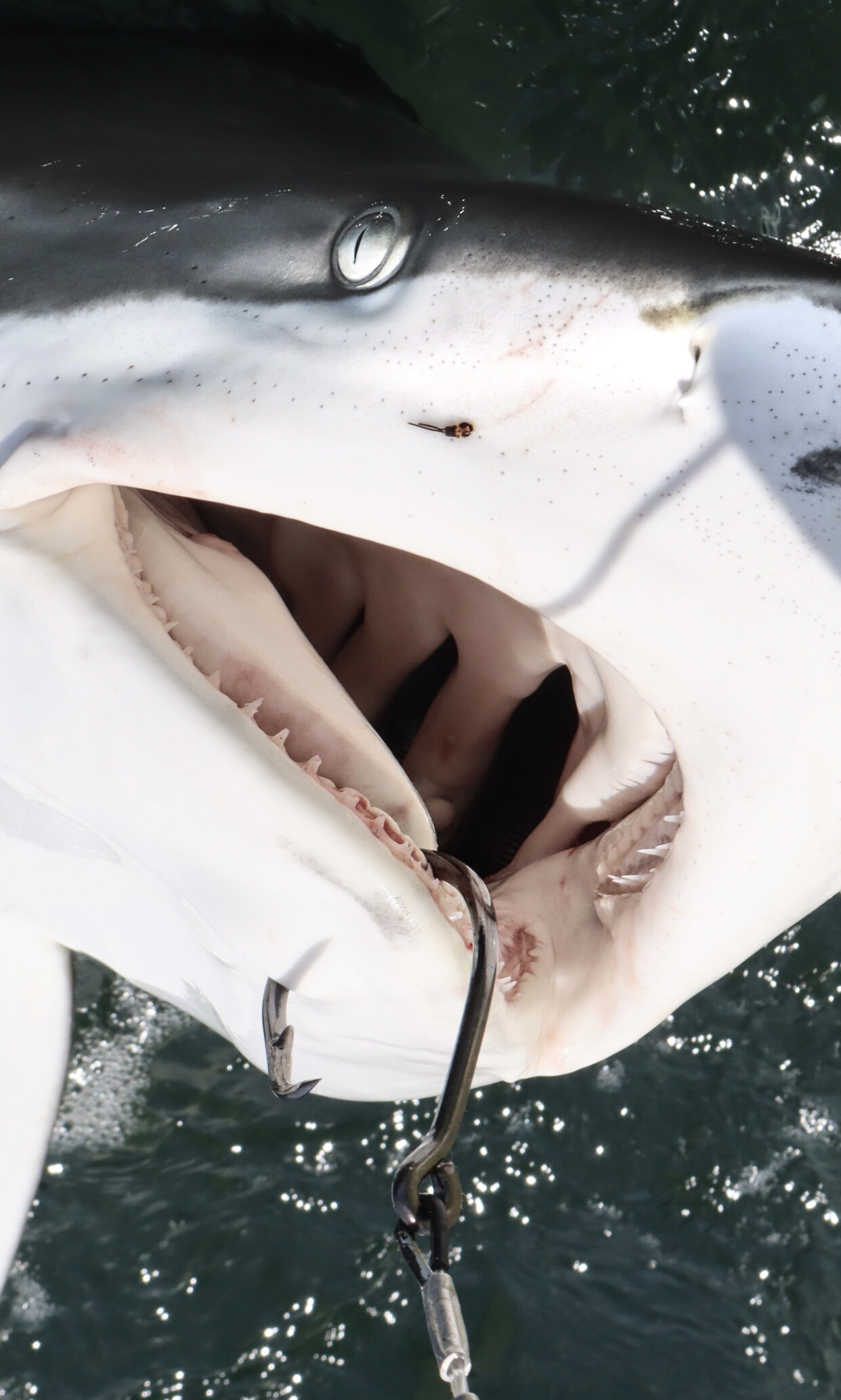Was 2021 A Particularly Shark-y Summer on Long Island?
Footage by Tim Regan (@SouthForkSalt)
Photography by Shane Etter (@BigOleMrKanish)
Written by Rich Nardo (@ntvli | @Heynardo)
Over the past few years, a lot has been made of the fact that the waters around Long Island have seemed a bit “sharkier” than usual. Several videographers shared regular drone footage of the near daily feeding frenzy of sharks attacking menhaden along the south shore. As Tim Regan pointed out to me, you could actually stand on the shore and witness hungry sharks launching themselves from the water consistently throughout the summer as well - something unprecedented on Long Island. A few weeks ago, a sighting at Lido Beach marked the 20th shark confirmed near-shore at Nassau beaches this summer, which is more than triple the numbers by this time last year. All this begs the question: Are there more sharks lurking in our waters?
While an increase in shark population is likely true, the degree to which we’re seeing it play out in the media may be a bit misleading. Factors such as social media allowing each sighting to reach a greater audience and our increasingly sophisticated monitoring systems raising awareness of sharks where they had previously gone undetected may also be playing a role in the perception that sharks are patrolling the waters ever closer to our favorite beaches and in greater abundance.
This article will take a look at why we may be seeing more sharks around Long Island, the types of sharks that call our waters home, and what it actually means for our marine ecosystem. I’m fortunate enough to be collaborating with two of my favorite content creators on the subject - wildlife photographer and mate on Triton Charters, Shane Etter (@BigOleMrKanish), and East End Surf/Fly Fishing Guide/On The Water Magazine Field Editor, Tim Regan (@southforksalt). I am very grateful that both lent their content and insight to the piece!
Reasons We May Be Seeing More Sharks Around Long Island
Climate Change
Surprise, surprise...one of the top reasons that experts believe we may be seeing more sharks in the area comes back to climate change. Since 1960, water temperatures between Cape Hatteras, North Carolina and the Gulf of Maine have risen an estimated 3.6 degrees Fahrenheit according to National Geographic. As the coastal waters get warmer, a lot of fish populations are shifting north.
Case in point, the arrival of large numbers of blacktip and spinner sharks. Traditionally, New Jersey has marked the northern limits of both species’ range. Over the past few years, they have increasingly visited Long Island during the summer months. The sheer number of spinners where they have rarely been seen before was extraordinary. Shane Etter points out that on a single shark charter aboard the Triton, they caught over a dozen spinner sharks, even doubling up at one point.
Scientists believe this is either due to the waters down south getting too hot for their liking or the rising water temperatures pushing the fish they prey on our way (which would offer an explanation for the insane size of the bunker schools that we’re also witnessing of late). Either way, the root cause comes down to climate change induced rising water temperatures.
Better Monitoring
As mentioned earlier, we are much better at monitoring what lies below the water surface these days - just look at Tim’s footage if you need proof. Hans Walters (of the Wildlife Conservation Society) says that the organization has a mantra “There are more people seeing sharks because there are more people, with more smartphones and drones and social media”. Each shark sighting offers a news outlet or Instagram page the potential for a viral moment.
Healthier Ecosystem
That’s right, a healthier ecosystem around Long Island could be contributing to the spike in sharks patrolling our waters. This is part of a cycle that started with an increase in the populations of prey fish like menhaden, as well as seals. In turn, apex predators, such as Great White Sharks, arrived in larger numbers. These apex predators regulate the population of their food sources, making for a robust and healthy ecosystem. As countries realize that top predators bring balance to their waters, tighter regulations for the harvesting of sharks (including complete closures on at-risk species such as sandbar, dusky, and sand tigers) are being imposed.
What Sharks Call Long Island Home?
Sharks have called Long Island home way before humans settled in. Traditionally, there are over 20 species that call New York home for at least part of the year. Here are a few of the most prominent.
Great White Shark - The most infamous of all selachimoprha (the scientific name for modern sharks). More than 30 great whites have been tagged off the shores of Long Island in the past five years. Additionally, there are nurseries off Montauk Point and in the New York bight. Long Island plays a big part in the migratory patterns of these massive sharks, and our waters are way better off because of their presence.
Mako Shark - Makos are my favorite species of shark - the perfect blend of athleticism and intelligence. The Mako is the fastest shark in the world, clocking in at up to 43 mph. They also possess the greatest brain-to-body ratios of any shark and are renowned for their complex social and critical reasoning skills. They’re native to Long Island and can be potentially dangerous due to their power, speed, and aggressiveness.
Basking Shark - These gentle giants can grow up to 40 feet long and live for around 50 years. They’re slow and docile, and feed exclusively on microscopic organisms called zooplankton.
Blue Shark - These beauties are truly a pelagic species, preferring to stay way off shore. They are very curious, open-water predators that use their long pectoral fins to ride currents as they undertake their daunting migration every year.
Brown Shark - One of the most common species around Long Island, the Brown (or sandbar) shark can reach up to eight feet long and spend most of its time close to shore. Still, they are not considered dangerous as their diet consists of small fish, mollusks, and crustaceans.
Thresher Shark - Another gentle giant, thresher sharks have no interest in human beings. That being said, their iconic tails can be half their body length (they grow to 20 feet) and you will want to stay clear of that thing when it gets to thrashing.
Dusky Shark - Another large coastal species, duskys can get up to over 14 feet and weigh north of 700 pounds. Also known as the shovelnose shark, they can carry the strongest bite force of any shark species.
Bull Shark - Bull sharks are large, they’re aggressive, and they live close to shore. Bulls are responsible for the third most fatal shark attacks of any species behind the Great White and Striped Tiger Shark. They’re also able to survive in freshwater, and were the species behind the famous 1916 shark attacks in Matawan, New Jersey that inspired the movie Jaws.
Hammerhead Shark - Hammerheads are large and aggressive - definitely not a species you want to find yourself in the presence of while swimming. Many people are surprised to find that we have hammerheads around Long Island, but sightings are becoming more common.
Sand Tiger Shark - Sand Tigers are believed to be behind the 2 non-fatal, unprovoked incidents in the surf off Fire Island in 2018. Scientists from the New York Aquarium discovered a nursery of Sand Tigers in the lagoons of the Great South Bay. It now consists of at least 15 tagged specimens.
Smooth Dogfish - Bait thieves! These small, common sharks are also known locally as sand sharks and love to steal your bait when bottom fishing around Long Island. They’re seemingly everywhere around here, but are considered harmless to humans as their teeth are small and blunt in order to crush and grind their prey (generally crabs and lobsters).
Blacktip Sharks - Blacktips are one of the newcomers to our waters that were mentioned earlier. They can range from 4 to 8 feet and spend most of the year in Florida before heading north for the summer. ‘North’ used to mean between the Carolinas and southern New Jersey, but climate change has brought them to Long Island during the summer months.
Spinner Sharks - The other ‘rookie’ on Long Island that is quickly establishing a large population is the spinner shark. They resemble a larger version of the blacktip shark and get their name from the spinning leaps they make while attacking schools of bait. The fact that they speed vertically through these schools often result in breaching the surface, which would explain the sightings from shore described by Tim earlier in this article.
Bottom line...’more sharks’ is a good thing!
In a day and age, where most environmental news is of the bad variety, especially with the ocean, a high number of sharks in the water is a headline that we can be happy about. Global shark populations were decimated by overfishing and pollution, with numbers dropping 70% since 1970. More sharks may be the first signs that we could be righting the ship.
In terms of their direct influence on the ecosystem, sharks help with species diversity by regulating unchecked predation by others lower down the food chain (such as seals). In an article I found while researching the topic, OCEARCH founder, Chris Fischer, notes that just one great white shark in an area can result in seals eating a quarter of what they normally would. “Without that shark, there are hundreds of seals that can ‘over-forage’ and wipe out cod, mackerel and lobster” Fischer continues.
I think the next line in the OCEARCH founder’s statement is the perfect way to close this article: sharks are needed “so our grandchildren can eat fresh fish in the future. All those baby white sharks are our future balance keepers”.
References
https://www.livescience.com/sharks-vacation-in-hamptons.html
https://www.dec.ny.gov/animals/117460.html
https://q1057.com/are-you-safe-swimming-with-sharks-off-the-coast-of-long-island/?utm_source=tsmclip&utm_medium=referral
https://abc7ny.com/lido-west-beach-shark-spotting-nassau-county-20th-sharks-sighting-town-of-hempstead/10947539/
https://newyork.cbslocal.com/2021/08/12/rockaway-beach-lido-beach-shark-sighting/
https://www.nytimes.com/2021/07/30/nyregion/shark-sighting-long-island.html
https://gothamist.com/news/cuomo-launches-investigation-into-sharks-after-two-kids-are-bitten-off-fire-island
https://pix11.com/news/local-news/multiple-shark-sightings-off-long-island-whats-bringing-them-and-how-to-avoid-them/
https://blog.therainforestsite.greatergood.com/cs-sand-tiger-sharks-longisland/
https://www.dailymail.co.uk/news/article-9680347/Shark-taggers-warn-four-huge-great-white-sharks-prowling-waters-NY-NJ.html
https://www.audacy.com/1010wins/news/local/3-great-white-sharks-tracked-off-long-island-new-jersey
https://shelterislandreporter.timesreview.com/2019/08/20/shark-sightings-something-celebrate/
https://www.cbsnews.com/news/shark-sightings-new-york-coast-climate-change-scientists-say/
https://www.sciencedaily.com/releases/2021/03/210323090556.htm
https://www.cnn.com/2020/08/15/us/long-island-shark-sightings-trnd/index.html
https://www.the-sun.com/news/2893888/great-white-shark-spotted-new-york-beaches/
https://sofo.org/sofos-shark-research-education-program/
https://patch.com/new-york/montauk/900-lb-shark-freya-spotted-coast-montauk
https://gothamist.com/news/they-saw-fin-jones-beach-lifeguard-potentially-bitten-shark







Ask any wildlife photographer or explore based on Long Island and they’ll tell you that our home turf does not get nearly the credit it deserves when it comes to species diversity. In fact, I think it’s safe to say that most people think Long Island has a couple of raccoons, a possum here and there, and way too many deer out east and that basically sums it up.
This couldn’t be further from the truth. So for this article, we worked with some of the best wildlife photographers based on Long Island to highlight 10 species that most people might not know we have here.